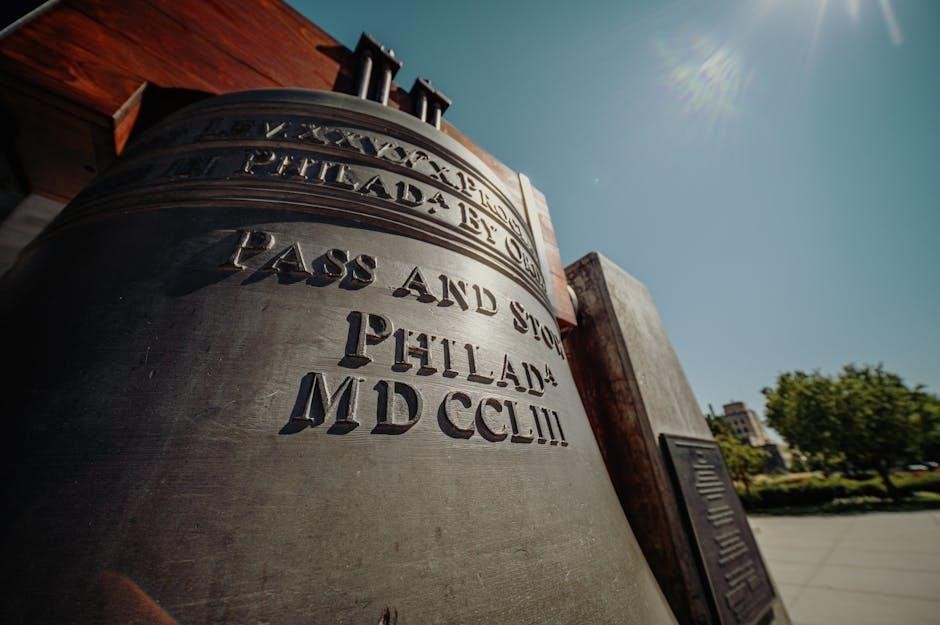
Vladimir Lenin’s The State and Revolution (1917) remains a foundational text in Marxist theory, exploring the state’s role in society and the transition to socialism. The 2021 PDF edition ensures free global accessibility, preserving Lenin’s critical analysis of state power and revolution.
Overview of “The State and Revolution”
The State and Revolution, written by Vladimir Lenin in 1917, is a seminal work that outlines Marxist theory on the state and its role in societal transformation. Lenin argues that the state is a tool of class oppression, emphasizing the necessity of proletarian revolution to overthrow capitalist structures. He draws on Marx and Engels’ ideas, proposing the dictatorship of the proletariat as a transitional phase toward a classless society. The book also critiques deviations within Marxism and stresses the importance of understanding revolution as part of a global struggle. Its insights into state power, class struggle, and socialist transition remain central to Marxist discourse. The 2021 PDF edition ensures free access to Lenin’s groundbreaking analysis, making it a vital resource for scholars and activists worldwide.
Significance of the PDF Edition
The 2021 PDF edition of The State and Revolution is a valuable resource for modern readers, offering free and universal access to Lenin’s seminal work. Its digital format ensures the text is easily searchable, annotated, and shareable, making it ideal for academic and personal use. The edition preserves the original content while enhancing readability through clear formatting and bookmarks for navigation. Its availability online democratizes access, allowing global audiences to engage with Lenin’s analysis of state power and revolution. This edition also serves as a critical tool for understanding Marxist theory, particularly in the context of contemporary discussions on socialism and class struggle. Its free distribution aligns with Lenin’s vision of empowering the proletariat through knowledge.
Purpose of the Article
This article aims to provide a comprehensive analysis of The State and Revolution by Vladimir Lenin, focusing on its key concepts, historical context, and modern relevance. It explores the Marxist theory of the state, the role of revolution, and the transition to socialism. The article also examines the significance of the 2021 PDF edition, highlighting its accessibility and role in disseminating Lenin’s ideas globally. By discussing the book’s themes, such as class struggle and the dictatorship of the proletariat, the article seeks to illuminate Lenin’s vision for a socialist society. It is designed to serve as a resource for students, researchers, and enthusiasts of Marxist theory, offering insights into the enduring importance of Lenin’s work in understanding political and social change.

Background of the Book
The State and Revolution was written by Vladimir Lenin in 1917 during the Russian Revolution. It analyzes the state’s role, class struggle, and socialist transition, providing theoretical groundwork for the Bolshevik movement amid the upheaval of World War I.
Historical Context of 1917
The year 1917 was marked by profound social and political upheaval in Russia. The Russian Empire, weakened by World War I, faced economic collapse, widespread famine, and growing discontent among workers and soldiers. The February Revolution overthrew the tsarist regime, establishing a provisional government, but it failed to address the crises, leading to rising support for radical change. Lenin, in hiding from the Provisional Government, wrote The State and Revolution to address the urgency of revolution and the role of the state. The text reflected the chaotic backdrop of 1917, emphasizing the necessity of proletarian revolution and the transition to socialism amidst imperialist war and societal collapse.
Lenin’s Motivations for Writing
Lenin wrote The State and Revolution to address the theoretical underpinnings of the state and revolution, countering counter-revolutionary trends within Marxism. His primary motivation was to clarify the role of the state before and after a proletarian revolution, emphasizing the dictatorship of the proletariat as a necessary transitional phase. Lenin sought to provide a clear theoretical foundation for the working class to achieve liberation, influenced by the tumultuous events of 1917 and World War I. By exploring these concepts, Lenin aimed to equip revolutionaries with a comprehensive understanding of Marxist theory, enabling them to navigate the complexities of achieving and maintaining a socialist society. His work remains a cornerstone in Marxist literature, guiding revolutionary movements globally and continuing to influence contemporary political thought.
Key Themes and Objectives
The State and Revolution explores the Marxist theory of the state, emphasizing its role as an instrument of class domination. Lenin examines the necessity of the dictatorship of the proletariat as a transitional phase to achieve a classless society. A central theme is the withering away of the state, where state structures become obsolete as socialism progresses. Lenin also critiques counter-revolutionary trends within Marxism, advocating for a return to its revolutionary essence. The book underscores the importance of understanding the state’s role in revolution, particularly in the context of imperialist war. Lenin’s objectives include providing a theoretical framework for proletarian revolution and empowering the working class to dismantle capitalist structures, ensuring a clear path to a socialist future.

Key Concepts Explored in the Book
The State and Revolution delves into Marxist theory, class struggle, and the state’s role in society. It examines the proletarian revolution, the dictatorship of the proletariat, and the eventual withering away of the state, transitioning to a socialist society. Lenin critiques counter-revolutionary trends and emphasizes the state as a tool of class domination, advocating for its abolition in achieving true freedom and equality for the working class.
Marxist Theory of the State
Lenin’s The State and Revolution outlines the Marxist theory of the state as a tool of class domination, asserting that it serves the interests of the ruling class. He argues that the state arises from class antagonisms and acts as an instrument of oppression, maintaining the dominance of the bourgeoisie over the proletariat. Drawing on Marx and Engels, Lenin emphasizes that the state is not a neutral entity but a reflection of economic and social relations. The theory posits that the state will “wither away” in a communist society, where class distinctions disappear. Lenin’s analysis critiques reformism and advocates for the proletariat’s role in dismantling the state apparatus to achieve true liberation and equality.
The Role of the State in Society
Lenin’s analysis in The State and Revolution posits that the state functions as an instrument of class domination, maintaining the power of the ruling class over the exploited. In capitalist societies, the state enforces the bourgeoisie’s dominance, perpetuating class struggle and suppressing the proletariat. Lenin argues that the state is not neutral but a tool of oppression, serving the interests of the dominant class. He emphasizes that the state’s primary role is to maintain the existing social and economic order, ensuring the continuation of exploitation. This understanding is central to Lenin’s call for the proletariat to seize state power and establish a dictatorship of the proletariat, a necessary step toward achieving a classless, stateless society. The state, in this view, is a critical battleground in the struggle for liberation and equality.
Class Struggle and the Proletariat
In The State and Revolution, Lenin emphasizes the central role of class struggle, asserting that the proletariat, as the exploited class, must lead the revolution to overthrow capitalist domination. The state, controlled by the bourgeoisie, suppresses the proletariat, maintaining economic and social inequality. Lenin argues that the proletariat’s historical mission is to abolish class distinctions and establish a socialist society. The 2021 PDF edition highlights Lenin’s insistence on the proletariat’s revolutionary potential, stressing the necessity of their leadership in achieving true liberation. By understanding the state’s role in perpetuating class oppression, the proletariat can unite to dismantle capitalist structures and move toward a classless society. This vision underscores the PDF’s relevance in inspiring modern Marxist thought and revolutionary action.
The Dictatorship of the Proletariat
Lenin’s concept of the dictatorship of the proletariat is central to The State and Revolution, defining it as a necessary transitional phase between capitalism and socialism. He argues that the proletariat must seize state power to suppress the bourgeoisie and defend against counter-revolutionary forces. This dictatorship is not arbitrary but a democratic rule of the majority, ensuring the establishment of socialist foundations. Lenin emphasizes that this phase is temporary, aiming to wither away the state as class distinctions disappear. The 2021 PDF edition underscores the importance of this idea, highlighting its relevance to modern discussions on revolutionary strategy and class power. Lenin’s vision remains a cornerstone of Marxist theory, guiding movements toward a stateless, classless society. His analysis in the PDF edition continues to inspire contemporary debates on socialism and revolution.
The Withering Away of the State
Lenin’s The State and Revolution introduces the concept of the withering away of the state as a central tenet of Marxist theory. He argues that once socialism is established, the state will gradually lose its necessity and disappear. This process occurs as class distinctions fade and society transitions to communism, where administrative functions replace coercive state power. Lenin emphasizes that this is not an immediate event but a natural outcome of socialist development. The 2021 PDF edition highlights this idea, making it accessible to modern readers. The withering away of the state reflects Lenin’s vision of a classless, stateless society, where collective management replaces hierarchical structures. This concept remains pivotal in discussions of socialism and anarchism, showcasing Lenin’s enduring influence on revolutionary thought. The PDF edition ensures this idea continues to inspire contemporary debates on the future of society.
The Transition to a Socialist Society
Lenin’s The State and Revolution outlines the transition to a socialist society as a revolutionary process led by the proletariat. He argues that the dictatorship of the proletariat is a necessary phase to dismantle capitalist structures and establish socialist institutions. The 2021 PDF edition emphasizes Lenin’s vision of a classless society, where state power is gradually replaced by collective management. This transition involves the abolition of private property and the redistribution of resources, ensuring equality and justice. Lenin’s work remains a cornerstone of Marxist theory, providing a roadmap for achieving socialism. The PDF edition ensures that these ideas are accessible to modern readers, fostering ongoing discussions about socialist transformation and its feasibility in contemporary contexts. Lenin’s analysis continues to inspire debates on revolution and societal change.

Themes and Ideas
The State and Revolution explores Marxist theory, class struggle, and the role of the state in society, emphasizing the proletariat’s role in revolutionary change and socialist transformation.
Criticism of Counter-Revolutionary Trends
Lenin’s The State and Revolution sharply critiques counter-revolutionary trends within Marxism, arguing that they undermine revolutionary goals. He condemns opportunism and reformism, emphasizing the need for a radical break with capitalist structures. Lenin asserts that the state is a tool of class oppression, and only a proletarian revolution can achieve true liberation; He warns against deviations from Marxist principles, stressing the importance of maintaining revolutionary purity. The 2021 PDF edition highlights Lenin’s analysis of how counter-revolutionary forces hijack revolutionary movements, reinforcing his call for a dictatorship of the proletariat. This critique remains central to understanding Lenin’s vision of a socialist future, making the text indispensable for studying Marxist theory and revolutionary strategy.
The Relationship Between Revolution and the State
Lenin’s The State and Revolution examines the intrinsic link between revolution and the state, arguing that the latter is a tool of class domination. He asserts that the state cannot be reformed but must be destroyed through revolution to achieve liberation. Lenin emphasizes that revolution is not merely a political act but a fundamental transformation of societal structures. The 2021 PDF edition underscores Lenin’s argument that the state serves the bourgeoisie, and only a proletarian revolution can dismantle it. This relationship is central to Lenin’s theory, highlighting the necessity of revolutionary action to transcend state oppression and establish a socialist order. The text remains a vital resource for understanding the interplay between revolution and state power in Marxist thought.

The Imperialist War and Proletarian Revolution
Lenin’s The State and Revolution highlights the role of imperialist war as a catalyst for proletarian revolution. He argues that imperialist wars, driven by capitalist competition, create conditions for revolutionary upheaval. The 1917 text emphasizes that World War I was a manifestation of imperialist contradictions, leading to widespread suffering and class consciousness among workers. Lenin posits that such wars expose the state’s role in serving capitalist interests, thereby galvanizing the proletariat to overthrow oppressive systems. The 2021 PDF edition underscores Lenin’s thesis that imperialist wars accelerate the inevitability of revolution, as they intensify class struggle and reveal the state’s true nature. This analysis remains pivotal in understanding the interplay between war, capitalism, and revolutionary transformation.
The Commune as a Revolutionary Model
In The State and Revolution, Lenin examines the Paris Commune of 1871 as a revolutionary model, emphasizing its significance as a workers’ government. The Commune demonstrated the proletariat’s ability to seize power and dissolve the old state apparatus, embodying the Marxist principle of the dictatorship of the proletariat. Lenin highlights the Commune’s features, such as the abolition of a standing army and the establishment of direct democracy, as a transitional step toward a stateless society. The Commune’s suppression underscored the challenges of revolution, but its legacy remains a powerful symbol of revolutionary potential. The 2021 PDF edition of Lenin’s work ensures this analysis is accessible, reinforcing the Commune’s importance as a historical and theoretical model for revolutionary change.

The PDF Edition
The 2021 PDF edition of The State and Revolution offers a well-formatted, free, and widely accessible version of Lenin’s seminal work, ensuring clarity and readability for modern audiences.
Features of the 2021 PDF Edition
The 2021 PDF edition of The State and Revolution is designed for optimal readability and accessibility. It features a clean layout, with clear typography and proper formatting for easy navigation. The document is fully searchable, includes bookmarks for quick access to key sections, and is compatible with all major PDF readers. This edition preserves the original text’s integrity while enhancing its presentation for modern digital platforms. It also includes introductory notes and a table of contents, making it user-friendly. The PDF is lightweight, ensuring fast downloads and smooth performance on both desktop and mobile devices. Its free distribution ensures that Lenin’s critical analysis of the state and revolution remains widely accessible to a global audience.
Accessibility and Free Distribution
The 2021 PDF edition of The State and Revolution is widely accessible, ensuring Lenin’s ideas reach a global audience. It is available for free download from various online platforms, including Marxist archives and academic repositories. The PDF is lightweight, making it easy to share and download across different regions. Its free distribution aligns with Marxist principles of equality and accessibility to knowledge. The text is compatible with multiple devices, including desktops, tablets, and mobile phones, ensuring readability for all users. This edition also supports formats like EPUB and MOBI for added flexibility. By eliminating financial barriers, the PDF edition democratizes access to Lenin’s seminal work, fostering a broader understanding of Marxist theory and its relevance to modern political discourse.

Technical Specifications of the PDF
The 2021 PDF edition of The State and Revolution is optimized for digital readability, with a file size of approximately 85MB. It is compatible with all major PDF readers, including Adobe Acrobat and free alternatives like SumatraPDF. The document is formatted for A4 pages, ensuring consistent layout across devices. OCR (Optical Character Recognition) technology has been applied, making the text searchable and selectable. The PDF includes bookmarks for easy navigation between chapters and sections. It is free from DRM (Digital Rights Management) restrictions, allowing users to print, share, and annotate the content. The file is compressed to balance quality and download speed, ensuring accessibility even for users with limited bandwidth. This edition is fully compatible with modern operating systems, including Windows, macOS, and Linux.

Impact and Legacy
The State and Revolution profoundly influenced Marxist thought, shaping the Bolshevik Revolution and inspiring socialist movements worldwide. Its modern relevance endures, offering insights into state power and revolution.

Lenin’s Influence on Marxist Thought
Vladimir Lenin’s The State and Revolution reshaped Marxist theory by emphasizing the state’s role in class struggle and the necessity of proletarian dictatorship. His analysis of the state as a tool of oppression challenged prevailing interpretations, offering a radical vision for socialist transformation. Lenin’s work built on Marx and Engels’ ideas, providing a practical framework for revolution and the transition to a stateless society. The 2021 PDF edition has ensured Lenin’s theories remain accessible, influencing contemporary Marxist scholarship and activism. His ideas on the withering away of the state and the dictatorship of the proletariat continue to inspire debates on socialism and revolutionary change. Lenin’s legacy endures as a cornerstone of Marxist thought, bridging theory and practice.
The Book’s Role in the Bolshevik Revolution
The State and Revolution played a pivotal role in shaping the Bolshevik Revolution by providing its ideological foundation. Written in 1917, the book outlined Lenin’s vision for overthrowing the Provisional Government and establishing a socialist state. Its analysis of the state as a tool of class oppression and its advocacy for proletarian dictatorship resonated deeply with revolutionary forces. The text served as a strategic guide, uniting Bolsheviks around the goal of seizing power and transitioning to socialism. Lenin’s arguments about the necessity of smashing the old state apparatus and creating a new revolutionary order were instrumental in mobilizing support for the October Revolution. The book’s influence was immediate, shaping the Bolsheviks’ approach to power and cementing its legacy as a defining text of the revolution. The 2021 PDF edition ensures this historic work remains accessible, preserving its impact for future generations.
Comparisons with Other Marxist Works
The State and Revolution stands as a cornerstone of Marxist literature, often compared to works by Marx and Engels. While Marx’s The Civil War in France and Engels’ The Origin of the Family, Private Property, and the State laid the theoretical groundwork, Lenin’s text provides a more direct, actionable blueprint for revolution. Lenin builds on Marx’s concept of the state as a tool of class domination but introduces the idea of the state’s eventual withering away under socialism. This differentiation sets The State and Revolution apart, offering a pragmatic approach to achieving socialist transformation. The 2021 PDF edition highlights these distinctions, making Lenin’s unique contributions accessible for modern readers. This work remains a pivotal text in Marxist theory, bridging theory and practice in a way that resonates across generations.
Modern Relevance of “The State and Revolution”
The State and Revolution remains a vital text for understanding contemporary political and social struggles. Its exploration of state power, class domination, and the transition to socialism resonates in today’s context of rising inequality and global unrest. Lenin’s analysis of imperialism and the role of the state in perpetuating oppression continues to inspire movements advocating for systemic change. The 2021 PDF edition ensures that Lenin’s ideas are accessible to a new generation, offering insights into the ongoing debate over socialism versus capitalism. The text’s emphasis on class struggle and revolutionary transformation aligns with modern discussions on democracy, power, and social justice, making it a timeless resource for activists and scholars alike. Its relevance endures as a guide for challenging oppressive systems and envisioning a more equitable society.
Vladimir Lenin’s The State and Revolution remains a cornerstone of Marxist thought, offering profound insights into the state’s role and the path to socialist transformation. Its timeless analysis, now accessible via the 2021 PDF edition, continues to inspire global movements seeking equality and justice, ensuring its relevance in modern political discourse.

Vladimir Lenin’s The State and Revolution (1917) is a seminal work that articulates the Marxist theory of the state, emphasizing its role as an instrument of class oppression. Lenin argues that the state must be dismantled and replaced by a dictatorship of the proletariat to achieve socialist transformation. He critiques counter-revolutionary trends within Marxism and highlights the imperialist war as a catalyst for proletarian revolution. The book also explores the concept of the withering away of the state in a socialist society. The 2021 PDF edition ensures global accessibility to Lenin’s ideas, preserving his analysis of state power, class struggle, and the transition to socialism. These ideas remain vital for understanding socialist theory and its implications for modern political movements.
Final Thoughts on the Book’s Significance
Vladimir Lenin’s The State and Revolution remains a cornerstone of Marxist theory, offering profound insights into the nature of the state, class struggle, and socialist transition. Its analysis of the state as a tool of oppression and its vision of a proletarian dictatorship continue to influence radical political thought. The book’s relevance extends beyond its historical context, addressing contemporary debates on power, governance, and social change. The 2021 PDF edition ensures Lenin’s ideas reach a global audience, making it an essential resource for understanding both historical and modern socialist movements. The State and Revolution is not just a historical text but a living document that challenges readers to rethink the relationship between state and society.